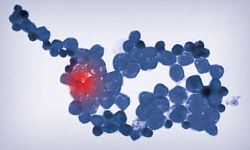Predictive Value of Select Gene Mutations Demonstrated in Phase III CLL Study
Next-generation sequencing in patients with chronic lymphocytic leukemia treated with the combination of chlorambucil and ofatumumab showed that the presence of TP53, SF3B1, and NOTCH1 mutations were predictive of reduced efficacy, according to the results of the phase III COMPLEMENT1 trial published in Haematologica.

Next-generation sequencing in patients with chronic lymphocytic leukemia (CLL) treated with the combination of chlorambucil (Leukeran) and ofatumumab (Arzerra) showed that the presence ofTP53,SF3B1,andNOTCH1mutations were predictive of reduced efficacy, according to the results of the phase III COMPLEMENT1 trial published in Haematologica.
In the study, 447 patients were randomized 1:1 to receive either chlorambucil or chlorambucil plus ofatumumab. Both cohorts were predictive of progression-free survival benefit overall (HR 0.53,P<0.01). The presence of SF3B1and TP53was associated with shorter progression-free survival (PFS). NOTCH1mutation, however, was found to be predictive of impact on PFS in the combination arm (HR 1.94; 95% CI, 1.25-3.92; P<0.01), whereas the monotherapy arm did not have predictive value (HR 1.01; 95% CI, 0.69-1.47; P=0.98).
Contrarily, patients with aNOTCH1wildtype mutation had a strong benefit to chlorambucil plus ofatumumab with a median PFS (mPFS) of 23.8 months compared with 13.3 observed in those who received chlorambucil alone (HR 0.50; 95% CI, 0.39-0.63;P<0.01). Patients with NOTCH1-mutated CLL did show this same benefit as those withNOTCH1wild-type.
The addition of ofatumumab to chlorambucil was also beneficial for patients withSF3B1andTP53mutations. For those withSF3B1-mutated disease, the mPFS was 17.3 months with the combination versus 13.1 with chlorambucil monotherapy (HR 0.53; 95% CI, 0.29-0.97,P=0.03). Patients withTP53mutations had a 12.8-month mPFS following treatment with ofatumumab plus chlorambucil compared with the 3.7-month mPFS observed with chlorambucil alone (HR 0.49; 95% CI, 0.23-1.05, P=0.05).
A total of 383 patients received NGS and 304 mutations were identified includingNOTCH1(17.0%),SF3B1(14.1%), ATM(11.7%), TP53(10.2%),
POT1(7.0%), RPS15(4.4%), FBXW7(3.4%), MYD88(2.6%), and BIRC3(2.3%). In 11.5% of patients, no mutations or chromosomal aberrations were observed. Tausch et al noted that most mutations lacked prognostic significance, but this excludedTP53,SF3B1,and NOTCH1.1
The presence ofTP53mutations led to a significantly lower overall response rate (HR 5.20, P<0.01). In terms of PFS), outcomes were also significantly decreased in patients with TP53(HR 2.02,P<0.01), SF3B1(HR 1.66,P<0.01), and NOTCH1mutations (HR 1.39, P=0.03). Patients with TP53mutation also experienced a shorter overall survival (OS), which was consistent for patients in the overall population (HR 4.25, P<0.01), and those with 17p deletion (HR 2.56, P=0.03). Another finding that was significantly prognostic was the number of mutated genes. Specifically, patients who harbored 2 or more mutated genes have a shorter PFS and those with at least 1 of the target mutations had a significantly shorter OS, but the number of mutated genes did not correlate with OS.
High variant allele fractions (VAF) of the mutant allele were a result ofTP53and ATMmutation. In addition, a VAF ≤10% did not occur often in patients withTP53mutations and were absent in those with MYD88mutations. But, VAF ≤10% was present in a significant number of subjects with SF3B1,NOTCH1, orFBXW7mutations. The investigators also analyzed the presence of minor allelic fractions and noticed a significantly shorter PFS in patients with minor SF3B1mutated clones compared with wild-type clone (HR 3.09; 95% CI, 0.67-14.30; P=0.01). The impact of minor allelic fractions was not significant in participants with NOTCH1mutations (HR 1.54; 95% CI, 0.71-3.34; P=0.26). An analysis of the relationship between NOTCH1and treatment was also conducted based on the fact that NOTCH1demonstrated the highest impact. The analysis showed that a predictive value inNOTCH1(P= .05).
COMPLEMENT1 was an open-label, randomized, multicenter study. Patients were randomized to receive either chlorambucil 10 mg2on days 1 to 7 for a period of 28 days plus ofatumumab 300mg on day 1 for the first cycle and 1000 mg on day 8 for subsequent cycles or chlorambucil alone. The primary end point of the study was PFS and some of the secondary end points were the number of participants with an overall response, the number of participants who were negative for minimal residual disease, overall survival (OS), time to response, and duration of response. The study was terminated prior to completion with 62% of patients having been treated with next-line therapies, which greatly impacted the OS results.2
Patients aged 18 years or older were eligible to be included in the study given they had a confirmed CLL diagnosis and active CLL requiring treatment, were not candidates for fludarabine-based therapy and had no prior treatment for CLL. The study excluded individuals with inadequate blood values, inadequate liver and kidney function, CLL transformation, CLL-related central nervous system involvement, and those who were participating in any other clinical trial.
“The major implication from our observation is the need to understand and circumvent the resistance against CD20 antibodies as they remain an important element in the treatment of CLL and furthermore confirm the role of recurrent mutations in trials with novel treatment principles such as BTK-, PI3K- and BCL2 inhibition,” wrote Tausch et al.
References
- Tausch E, Beck O, Schlenk RF, et al, Prognostic and predictive role of gene mutations in chronic lymphocytic leukemia: results from the pivotal phase III study COMPLEMENT1.Haematologica. 2020; 105:2. doi:10.3324/haematol.2019.229161
- Ofatumumab + chlorambucil vs chlorambucil monotherapy in previously untreated patients with chronic lymphocytic leukemia (COMPLEMENT 1). ClinicalTrials.gov. https://bit.ly/2HdCYSd. Accessed February 10, 2020.